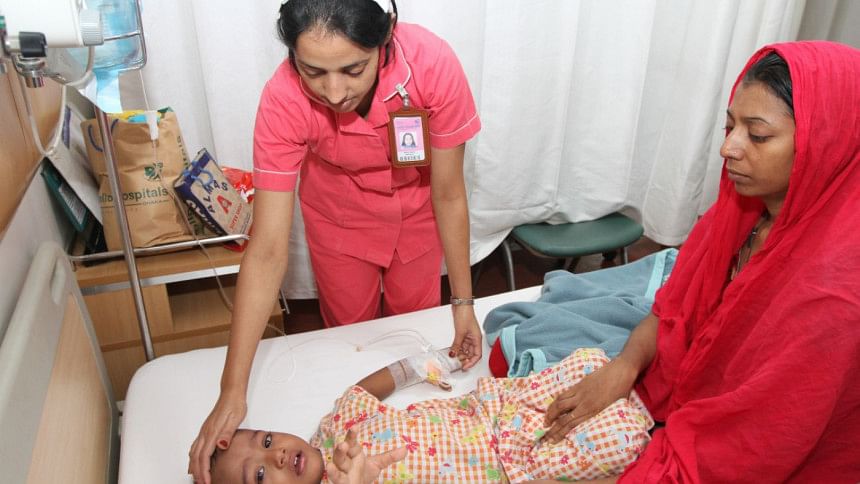Bringing healthcare to the patient

The health, nutrition and population (HNP) sector of Bangladesh has achieved commendable success in recent years. Such successes have been manifested in the reduction of population growth rate, maternal and child mortality, considerable increase in the life expectancy and eradication of most communicable diseases.
More interestingly, this level of performance has been accomplished mainly by the public sector. The HNP sector of Bangladesh provides a test case of what a public sector can achieve, despite existing bottlenecks in health service delivery. It also proves that even in a private enterprise economy, the public sector can initiate and lead development in many welfare activities.
This is, however, certainly not to suggest that the sector has achieved all that is desired. Rather, we have to take into cognizance that we still have a long way to go. In order to achieve the required level of development, the sector has to combat a number of challenges in the near future.
The HNP sector has to reduce regional and socioeconomic disparity in provision of healthcare, eliminate shortage of crucial manpower and absenteeism of providers, ensure appropriate input-mix, and allocate resources based on need assessment. Besides, a major concern is the persistence of low use rate of maternal, neonatal and child health (MNCH) services, especially in the remote and backward regions. Apart from the fact that some difficulties are inherent in MNCH services, one of the main reasons for the sluggish growth of use of these services in Bangladesh lies in the existing method of preparing and implementing a plan for the sector.
The conventional method is based on the top-down approach of allocating resources. Since it does not take into account the actual need for services and inputs in the areas, a mismatch between need and supply frequently ensues. As a result, the supply of inputs falls short of the amount required to cater to the existing need and wastage of resources crops up.
To overcome the existing hurdles, local need-based planning has become a must for efficient and equal healthcare service provision. The role of consumers and community should be enhanced in planning and management of health services.
Decentralisation is usually defined as the process of distributing or dispersing functions, powers, human resources, and commodities away from a central location. In a country where the central authority largely controls both public and private sector activities, the possibility of establishing more locally operated and responsible institutions hold out great attraction as they can be more transparent and accountable.
Based on this idea, national and regional policymakers in many countries have introduced decentralisation strategies. Decentralisation has the potential, through enhanced local participation, to increase access to services, good governance, efficiency of resource use, and improve quality of care (Saltmen et al. 2007).
The HNP sector programme of Bangladesh addressed the issue of decentralisation and local level planning (LLP) in the Health Population & Nutrition Sector Strategic Plan (2011-2016) of Ministry of Health and Family Welfare.
The government of Bangladesh has already started piloting decentralised planning in the health sector in some selected upazilas (sub-districts) through the Directorate General of Health Services (DGHS) and the Directorate General of Family Planning (DGFP). In the cases of these LLP models, only the plan was prepared but it was not properly implemented and could not obtain the benefits of LLP.
Besides, the government has been implementing district evidence-based planning (DEPB) in all upazilas of 25 districts, using financial and technical assistance from UNICEF. The DEPB appears as a more comprehensive method, embodying the identification of bottlenecks and need assessment in plan preparation, budget allocation and supply of inputs, and capacity building.
Recently, the baseline survey of a study on impacts of DEPB has been carried out by the Institute of Health Economics, University of Dhaka with the support of UNICEF in close collaboration with DGHS and Health Economics Unit of MoHFW; the end-line survey on it will be conducted shortly.
In addition to the baseline survey, the study team has been constantly monitoring the progress of the implementation of DEPB. It has appeared that the implementation of the intervention is progressing along the right track and it has already demonstrated that the intervention has been creating positive effects on use of MNCH services.
The providers and managers at the local level are greatly enthusiastic and are fully prepared to implement DEPB; the additional inputs have been mostly procured, the community and the stakeholders are now satisfied with and involved in the planning and implementation process, and accessibility has increased even in the remotest areas.
The preliminary findings, therefore, are very positive, creating the rationale for undertaking the interventions.
Based on the findings gathered so far, it can be surmised that once implemented on a larger scale and made sustainable, the sector will be able to achieve the targets about MNCH use in a short period of time.
However, some caveats are in order. In order to reap the full benefits of DEPB, some measures should be undertaken urgently. The magnitude of absenteeism of providers has to be reduced, auxiliary inputs should be in place, and Behavioural Change Communication campaigns should be beefed up.
Furthermore, the intervention has to be transformed into a budgeted activity without delay - the government should allocate funds for this activity to increase its financial sustainability. At the same time, the local authorities and community should also recognise that decentralisation can never be effectively attained until they can mobilise at least some funds locally.
The writer is Director, Institute of Health Economics, University of Dhaka and can be contacted through email [email protected].

 For all latest news, follow The Daily Star's Google News channel.
For all latest news, follow The Daily Star's Google News channel. 








Comments